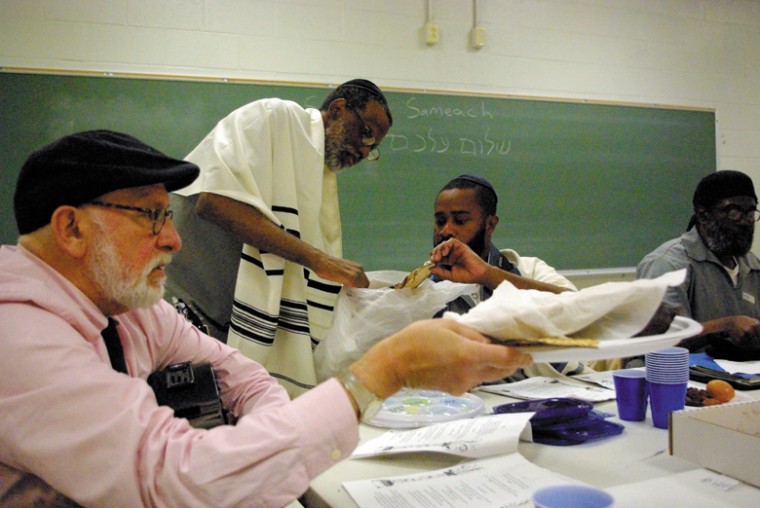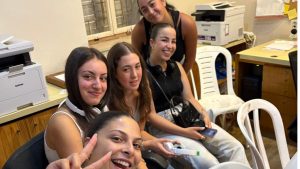Why is this seder different from all other seders?
Published April 18, 2012
CHARLESTON, Mo.—Ten inmates, all but one part of the prison’s Jewish Worship Group, are seated around a large rectangular table, eagerly waiting. Several wear yarmulkes and have tallits draped over their shoulders while the others gladly accept one of the knitted skullcaps Rabbi James Stone Goodman has brought along and hands out.
“Make sure you get one for Cedric,” Juan Howard, the group’s inmate facilitator, instructs. Howard explains Cedric is “in the hole” and therefore can’t be at today’s seder.
Inside a large plastic storage container, the rabbi unpacks assorted Tupperware, each filled with a key ingredient—parsley, hardboiled eggs, charoset, horseradish and so on. Boxes of Yehuda-brand matzah sit on the table but Goodman pulls out some more, including handmade, round shmura matzah that he tells the group came all the way from Brooklyn, N.Y. He also unveils a roasted beet to represent the shank bone, which he had wrapped in foil. But on our way in, as we passed through the first of three major security checks, the rabbi was reminded aluminum foil isn’t allowed.
“I knew that but I forgot,” says Goodman, slightly annoyed with himself. After all, he had taken care to buy grape juice in plastic bottles since he knew glass was forbidden. No big deal, though. The guard hands him some paper towels to wrap up the beet, then disposes of the confiscated foil.
A few minutes later, another guard hands each of us a small electronic box to tuck into our pant’s pocket, with a string attached. We are told that if we encounter any problem, pull the string and help will come running. No guard will be in the room where we are meeting with the Jewish Worship Group.
Welcome to Passover at the Southeast Correctional Center in Charleston, Mo., about 145 miles southeast of St. Louis. The maximum-security prison, which opened in 2001, houses 1,600 men, many of whom are serving 30-years-plus and life sentences. All of the inmates in the Jewish group are doing what is typically referred to as “hard time”; some are multiple offenders and have already been incarcerated upwards of 25 years for crimes including murder, sexual assault, armed criminal action, first-degree assault and armed robbery.
In the beginning
Goodman has dressed up for the occasion. He looks daper in pink shirtsleeves, cuffed jeans, dark tie and black golf hat.
The rabbi has been driving the two-plus hours from St. Louis to Charleston every month for more than a year to meet with the prison’s Jewish Worship Group. He explains that his prison outreach began about 10 years ago when an inmate at the Jefferson City Correctional Center contacted him.
“I got a letter from a guy in jail saying other inmates were teasing him because he looked Arab but he was a Yemenite Jew,” says Goodman of Congregation Neve Shalom. “We started to correspond. He had a very traditional Jewish background and he was gay and was having problems integrating that part of him. I knew I could help him, so I suggested that he put me on his visiting list and I would go to see him.
“When I got to the prison all these guys were also waiting to see me because I was a rabbi. I would sit with one guy after another in a room like you see in the movies, with vending machines and people seated across tables (from the inmates they were visiting). I seemed to be helping these men so I kept going.”
Goodman says he still keeps in touch with the Yemenite Jew who has since been released and is now in California. In 2005, Goodman, along with St. Louisans Margie Kessler and Marsha Koski, formed Jewish Prison Outreach, with support from the St. Louis Rabbinical Association, Jewish Family & Children’s Services and Congregation B’nai Amoona. Over the years, JPO has evolved to include Jewish mailings and calendars to Jewish prisoners incarcerated in Missouri; a family and friends support group that meets regularly; mentoring, plus housing and job assistance for released inmates and Goodman’s monthly visits to several prison Jewish study groups, including the one in Charleston.
Of Missouri’s 31,053 prisoners, 960, or 3 percent identify themselves as part of the Jewish faith, according to the state’s Department of Corrections.
On our drive the rabbi notes that most of the Jewish inmates he sees are African-American and have embraced Judaism while incarcerated. He says they study “with such intensity” whatever Jewish materials he brings them or they can get their hands on. He also mentions how polite and deferential the group is with one another, and how kind they are to him. “It’s truly sweet,” he says, adding that nearly all have learned to read some Hebrew, and a couple, including Juan Howard, speak it almost fluently.
“When I asked how they did it, they explained that they are hungry to learn and they have the time,” Goodman says.
Passover in prison
As Goodman unpacks the seder essentials, it’s clear the guys are itching to begin. Typically, the prison’s Jewish study sessions take place for a couple of hours beginning at 1:30 p.m. on Thursdays while they hold Shabbat services on Saturday afternoons at 2:30. The weeks the rabbi isn’t there, Juan Howard usually leads the sessions.
Plastic seder plates appear, enough so that everyone has his own. Goodman passes around the Haggadahs and Tupperware containers so that each participant can load up his plate. A few inmates pour grape juice into plastic cups and pass them around. Then one of the guys leaves and quickly brings back a guitar for the rabbi to play.
Goodman starts by singing the order of the seder, beginning with the Kiddush. Washing the hands is improvised since the room has no sink; the table completely dominates the space, save a few skinny lockers where study materials and matzah are stored.
After the four questions, Goodman tells the story of the wandering Aramean, and then goes around the table, directing each inmate to “give a paragraph of your story.” Juan Howard, who goes by the Hebrew “Yechuel Ben Howard” and is serving extended time for robbery, says his story is one of “struggle and triumph . . . now trying to do deeds of mitzvah, striving to do tikkun olam.” Willie Taylor Jr., who was given the Hebrew moniker “Zephanyah Ben-Yisrael” by Goodman some months earlier, says his is a story of “redefining myself as a Jew. This is my goal. This is why I am here.”
Knowing our time is limited, the rabbi makes sure to keep the seder on track as he leads the group in reciting the 10 plagues, singing “Dayenu,” which is a highlight, and welcoming Elijah. At the conclusion, a few moments remain for a question or two. I ask what landed these men in prison and how they came to study Judaism.
Juan Howard, who wears a large Star of David around his neck, says he grew up with a Jewish mother in St. Louis while Pablo “Raphael” Gomez, who is serving a life sentence for assault, says he lived with Jewish foster parents in Cleveland Heights, Ohio and learned some Hebrew as a child. He is now deeply into studying the Old Testament and the Torah, he says.
“I started learning about Yah (God) back in 1980. Since then I have pursued the study of Judaism more and more and learned the language of Hebrew,” says Flennord D. Smith, who was given the name Izraa-El by Goodman. A skillful artist, Smith pulls out several of his drawings to show me. “My journey has taken me from oppression to asking Adonai to release me,” he adds.
The inmates say that it’s not easy being Jewish in prison. Kosher meals aren’t really an option, and Jewish reading materials and prayer books are limited. They would like more Jewish educational supplies, a working shofar, a menorah and “a portable mikvah,” says inmate Rederick E. Cummings.
Cummings, or “Emmanuel Ben-Israel” as he is known in the group, says he has studied many religions including Christianity, Mormonism and the Moorish Science Temple but “Judaism turned my life around.”
“I came from a background of abuse, drugs, the whole nine yards. I’ve been a bad guy,” he continues. “But with the blessing of Yah, I know there is something good and salvageable in me. I am worthy of love, redemption and a second chance.” He has been in prison since 1987 and is serving a 40-year sentence.
Then he adds: “Judaism has brought discipline to where there was chaos.”















